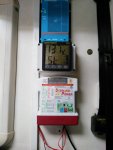The Sterling BB1230 Battery to battery charger.
The Sterling BB1230
Battery to
battery charger.
here is the data that I am using to meet my objectives:
From the BB1230 box :
The Pro Bat Ultra is a
DC to DC charger that is installed between a
battery bank which is being charged (
typically a starter battery being charged by an alternator/battery charger) and a
battery bank that you wish to charge (auxilliary / house / bow thruster).
The charger shall provide a 5 stage charging profile to these output batteries.
Keywords:
DC to DC charger
This unit will reduce the input voltage if it too high and boost if its too low ensuring the batteries receive their optimal charge voltage.
The unit is
typically deployed using the engine
battery and alternator as the source / input and an auxilliary
battery as the target or
battery to be charged.
Keyword Typically.
However in my case, my requirement is to use a pair of unused terminals on my
Victron MPPT controller called the LOAD terminals, as a source of power which can be fed into the BB1230 and used to maintain the engine
battery.
So I will end up with MPPT Load output at 14v / 14A as INPUT to the BB1230.
The BB1230 Output will then provide a proper 5 stage charging profile which I will then connect directly to the engine
battery.
The existing Schaudtt EBL-100 already handles the engine and AUX batteries when driving or on a 220v EHU so the typical use for the BB1230 would simply duplicate an existing EBL-100 function and is not addressing the need to charge the engine
battery from
solar.
So an overview is as follows :
During daylight hours the 340Watt PV panels feed into a
Victron 40 Amp MPPT controller.
The
Victron 40 Amp MPPT controller has 2 separate charging outputs :
A) is the usual BAT terminals, which I have connected to the 460Ah
Victron AGM Super Cycle batteries and can deliver up to 40A if there is enough sunshine. However, my 340 Watt panels will probably deliver a maximum of maybe 20 - 25 Amps to the controller.
The MPPT controller is configured for AGM batteries on the BAT terminals.
B) A pair of output terminals called LOAD, which will deliver 14 DC Volts at a max of 14 Amps raw DC - not profiled or managed, it is either there or not.
This source will be used to derive an INPUT into the BB1230 DC to DC charger.
As the Sterling literature says, the BB1230 will adjust the input voltage and ensure the target
battery is properly charged depending on the type of
battery being configured into the BB1230.
Both ends of the BB1230 will be seeing pure DC.
The MPPT terminals are all dead when it's dark so the BB1230 will not have any work to do.
This action is similar to parking the car - no alternator so no work to do.
So The MPPT BAT terminals are providing me an AGM charging profile while the LOAD terminals drive the BB1230 which will be configured for a Lead-acid
battery charging profile.
This gives me simultaneous charging of BOTH
battery banks and both are correctly profiled.
Status to date:
The MPPT charging of the AUX batteries has been in use for around 3 weeks of full time live-in conditions and work better than I expected.
Every day, even the gloomy ones, have seen my Aux batteries fully replenished by midday or earlier.
This demonstrates that I have plenty of spare
solar power available that will easily charge an 95Ah engine
battery in it's spare time.
Now to be honest,the engine
battery charging via the BB1230 is unproven, but the specs say it will work just fine.
I intend to jerry-rig the BB1230 and watch it for a day or so before I hang it onto a bulkhead and cable it up permanently.
Or possibly just go ahead with the full installation - as my confidence level is unaffected by irritating Dog Hairs.
As Ian Drury sang "It's nice to be a lunatic"
Thank you dear reader for your close attention.
james





